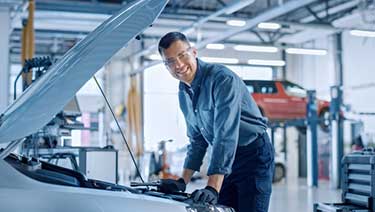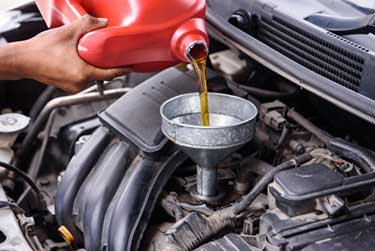
Written by Kayla Jane Barrie Updated on Mar 03, 2025 6 mins read

Car maintenance is part of the responsibility of owning a vehicle. Understanding when and what to service throughout the year will improve your vehicle safety and enhance performance. It will also save on repairs and increase resale value.
If you want your vehicle to last, you need to follow the maintenance schedule outlined in your manual. Regular vehicle maintenance lowers the chance of accidents caused by faulty brake systems, worn-out drive belts and poor tire tread. It also gives you peace of mind, especially when driving in poor conditions. Here’s what you need to know about regular car repair and maintenance.
The scheduling of car maintenance is based on mileage or time intervals. In general, you should take your car in for an oil change every 5,000 to 7,000 kilometres or every 6 months. If you suspect there is an issue, have it checked out sooner. Check your manual for maintenance recommendations for your vehicle brand.
Regular car maintenance includes oil and filter changes, fluid inspection and top-ups, air and fuel filter replacement, tire rotation and brake inspection. It also is an opportunity to check for other issues that could become problems in the future.
The most important areas to keep well-maintained on your car are the oil, brake pads, air filters, and tires.
Unless you have experience working with vehicles, avoid DIY car maintenance. You could end up creating more issues and costing yourself more money. Generally, there are two main options for vehicle maintenance. You can visit your car dealership or a local mechanic shop. Here are some things to consider if you are planning on going to the dealership or the local shop.
Car dealerships can be pricier. The mechanics are factory-trained and are very experienced in working on your type of vehicle. The prices are also higher due to higher labour rates and factory parts as the main options for replacement.
Dealerships have access to your vehicle’s full history, including service records, recalls and warranty-related repairs. Your car will be examined before it goes into service, and any recalls or updates that need to be made can be done in one stop.
A local mechanic can often get maintenance done at a lower cost. All of the services outlined in the owner’s manual, such as brake service, transmission service, and filters, can all be handled at an independent mechanic shop. Mechanics at the local shop might not be specialized in your type of vehicle, compared to the brand dealership. Research the shop before visiting to make sure they are reputable.
Whether you own or lease your vehicle, both options have their pros and cons to handle your car maintenance needs. Consider your budget and what needs to be taken care of.
Always check your driver’s manual to see the recommended maintenance for your car. Here is a general list of when to bring your car in for maintenance. Timelines and recommendations will vary by car brand and model.
MonthlyIf you are buying a new or used car, car maintenance fees should be a factor in your decision. To ensure longevity in your vehicle, always follow the scheduled maintenance and bring your vehicle in for a yearly check-up. Keep track of your receipts and records of your vehicle maintenance.
Electric cars require less maintenance than conventional vehicles because there are fewer fluids (oil, transmission fluid, for example) to change and fewer moving parts. However, they still have vehicle maintenance that needs to be followed. The battery, electrical systems, electrical motor and electronics maintenance should be followed according to your vehicle guide.
It’s a good idea to do a visual inspection of your vehicle before driving. Here are a few daily car maintenance tips to practice. When you approach your vehicle, look for any fluid leakage, under-inflated or flat tires, or hazards such as ice, snow or dirt that can interfere with the steering, visibility, or braking.
From the driver’s seat, make sure your view is unobstructed, the lights are working, and there are no illuminated warning lights. While you are driving, be alert for unusual engine or exhaust noises and squeaking or grinding noises from the brakes. If you notice any changes with your vehicle, make an appointment with your mechanic.
Car maintenance costs roughly amount to $1,500 annually. You should budget $100 to $125 monthly for car maintenance such as oil changes, fluid changes and filters. Some months, you won’t spend anything, and others, you may have a higher maintenance bill.
People want to drive the most reliable cars. If you are in the market for a new vehicle, you might be interested in buying one that has low maintenance costs. Well-maintained cars will last the longest. Toyota vehicles are known for providing drivers with the best value.

If you have experience working with vehicles, doing an oil change at home can save you money. Here are the pros and cons of doing an oil change at home versus using a mechanic.
ProsHere are the most commonly asked questions about car maintenance.
Follow your owner’s manual maintenance schedule to know exactly what and when you should get serviced. Also, consider a yearly check-up to ensure all systems, brakes, emissions, hoses, and belts are functioning at their best.
Depending on what needs to be serviced, your vehicle will need regular maintenance every 5,000 to 10,000 kilometres, or every six months. Here’s a look at the necessary recommendations to have your car serviced.
If you neglect your car’s service requirements, it can result in higher repair bills. However, if you keep up with scheduled maintenance trips, it can save you money and help your vehicle last longer.
Most of the time, you will need to pay for vehicle maintenance on a leased car. Sometimes, car dealers will include oil changes as part of your lease agreement. Always hold onto your receipts and copies to prove any work has been done on your car.
Yes, you should keep all maintenance reports about vehicle maintenance. Service records, purchase receipts, initial paperwork and insurance should all be organized and kept safe. It will help eliminate any guesswork and unnecessary maintenance. Keeping receipts will also help you benefit from warranties on replacement parts. When selling a car, buyers often request maintenance records to ensure the vehicle is properly maintained. This can also increase the resale value.
If the repairs are necessary due to an accident, your insurer will likely cover them. This will depend on the type of car insurance quotes you have searched for and added to your vehicle.
We hope you find the tips and information helpful. Keeping your vehicle maintained will save you money in the long run by preventing expensive maintenance costs for large repairs because of neglect. You will likely also get more on a trade-in or if you sell your car as it will be in better working condition. But most importantly, it will be safer to drive and less likely to break down. Driving a safe and reliable car is worth keeping it maintained properly.
| Categories | Auto |
|---|---|
| Tags | Repairs and Maintenance |
Read our insurance blog to get helpful tips, information and news.
Has your car been totalled in an accident? Is your car a write off? Learn about vehicle write offs for a total loss insurance claim.
Get the facts on Toronto's auto theft problem. We break down the data, reveal the most-stolen vehicles (including the Honda CR-V and Lexus RX 350), and show which neighbourhoods are most affected.
Dive into the world of auto theft with our blog on the most stolen cars in Canada. See the most stolen cars across Canada, including provincial lists for Ontario and Quebec, and learn how high-risk models can affect your car insurance premiums.
Drive safe this winter! Check out these tips for driving in snowy and icy conditions in Ontario. Get other helpful info and FAQs on winter driving.